Published
on 3
Oct 2014
|
All rights reserved.
|
|
|
It is hard to
imagine the "One Ford" policy finally expands to Mustang. For 50 years,
Mustang has been the symbol of "pony cars", a breed that lives only in
the America. It offers more performance per dollar than the
coupes and convertibles found elsewhere, but it is also
accompanied with an outdated styling, low-rent interior, poor
refinement
and, well, a live-axle rear suspension. In other words, it is a living
dinosaur. Ford could have kept it just the way it is, but its visionary
former CEO, Alan Mulally, saw the sales trend was declining, especially
in recent years when more and more young drivers shift from
traditional coupes to small SUVs or crossovers. How to stop the
declining trend? Globalization could be the answer. If Ford could make
the 6th generation Mustang appealing to the new generation of American
motorists and simultaneously satisfy the needs of the rest of the
world, its volume could be significantly boosted. By the way, this
could also answer the long-standing complaint that Ford lacks a sporty
coupe in the international market since the demise of Capri.
So here comes the first global Mustang. It will be available to Europe
as well as Asia for the first time ever. At the first glance, it looks
far more modern than the old dinosaur, yet it has lost few of its
traditional genes. There is still a clear visual link to the Mk5
Mustang and, surprisingly, even more so to
the original, 1964 model. This
is evident from the shape and size of its front grille, its
3-vertical-bar taillights and flat taillight panel, the
horizontal waist line as well as the recessed door skins. Nevertheless,
it
is by no means a retro design. On the contrary, its proportion is
thoroughly modernized,
with a sleeker front end, broader shoulders and fastback roofline –
though it keeps using a trunk lid instead of liftback. The sleek
proportion and the rear diffusers add a sophistication you can't
imagine on a pony car. While it is not exactly a wind-cheating design,
it no longer feels working against the laws of physics. I think the new
style will be welcomed by European motorists.
Size-wise, the new Mustang keeps the overall length and 2720 mm
wheelbase of the old car, but its modernized proportion means it is 38
mm wider and 35 mm lower. Kerb weight has been increased by 30-60 kg
because of the added sophistication, most notably the changeover to
independent multi-link rear suspensions (finally!). The Mustang has to
keep its low pricing strategy, so it could not afford weight saving
measures beyond the aluminum bonnet and front fenders. This means its
chassis construction is conventional. The front suspensions are
implemented by MacPherson struts. Steering is assisted by electric
motor as in any modern cars, and you can alter steering effort
(accompanied with throttle response and ESP intervention) across 4
modes. For more demanding drivers, there is a Performance package which
provides Torsen LSD, bigger brakes, stiffer suspension setting and
sportier wheels/tires etc. Just don't expect adaptive dampers, active
differential or 4-wheel-drive option. The Mustang does not pretend to
be an Audi.
There are 3 engines on offer. At the bottom of the range is a 3.7-liter
24-valve V6 carried over from the old car, though it is deliberately
re-rated from 305 to 300 hp to avoid embarrassing the mid-range 2.3
Ecoboost. The 2.3-liter Ecoboost is a long-stroke (94mm stroke x 87.5mm
bore) four-cylinder turbo. It reminds us the Mustang SVO sold in the
mid-1980s, whch was also a 4-cylinder turbo. However, the new engine is
much more advanced, featuring direct fuel injection, twin-continuous
VVT and a quick-acting twin-scroll turbocharger – the latter is a first
on Ford's Ecoboost engines (though commonly used by BMW). It produces a
remarkable 310 hp and 320 lbft of torque, 40 lbft more than the V6 and
is available 1000 rpm earlier. This allows it to employ taller gearing.
It might not be as smooth as the V6, but its lower fuel consumption is
very important to the sales in Europe, where every gram of CO2
counts. Both the 3.7 V6 and 2.3 Ecoboost can be mated with 6-speed
manual or 6-speed automatic gearbox.
At the top of the range is Mustang GT, powered by the familiar
5.0-liter 32-valves Coyote V8, now tuned to 435 hp and 400 lbft of
torque. Mating with it is an improved Tremec 6-speed manual. Because of
the slightly increased weight, the new Mustang does not enjoy any
advantages in performance against its predecessor, unless at higher
speeds where its superior aerodynamics starts taking effect. The V8 is
capable to sprint from rest to 60 mph in mid to high 4-seconds range
(depending on surface grip and whether you allow a 1-foot rollout
exemption), while the 2.3 Ecoboost is good for low-5-seconds. They are
still pretty fast, but with new pocket rockets like BMW 228i and M235i,
we are no longer so sure if the American pony car can return the
highest performance for the buck.
One thing the new car does quite well is the interior. The dashboard
design is conventional but also unmistakably Mustang, with plenty of
flashy plastics, bezels and silver toggle switches to remind you this
is an American performance car. If you are used to the Mustangs of the
old, you will be amazed that the materials and assembly quality on the
new car have been vastly upgraded to European level – well, not quite
the level of BMW or Audi but it would be decent to compare with cars
from European mainstream brands. Yes, you can find cheaper hard
plastics at lower level, and the switches might feel flimsy and not
well damped, but this is easily forgivable if you look at the price tag
– in the USA, the Mustang starts from only $25,000 for the Ecoboost or
$32,000 for the V8, plus $4,000 for the aforementioned Performance
package; In the UK, it costs £28,500 and £33,000
respectively with Performance pack included. The front seats offer
plenty of space for tall drivers. Not so great is the rear bench, which
is suitable to kids only. Considering the car’s size and long wheelbase
this is quite disappointing. Look at the slopping C-pillar and you will
understand why. You can't have a sporty appearance and roomy rear seats
simultaneously. If you put the latter on higher priority, turn to BMW
2-Series.
So how does the new Mustang feel to drive on the road? It is a mixed
experience. In terms of ride and handling, it is definitely a big
improvement from the old, solid-axle-suspended Mk5. The new body shell
feels a lot more solid. The multi-link rear suspensions now keep the
rear wheels perpendicular to the ground regardless of bumps, so you no
longer worry about mid-corner bumps deflecting the car from the path.
As a result, grip and traction are enhanced, and the handling becomes
more predictable. Composure is also improved by the independent
suspensions. There is less pitch and dive. In terms of ride, the car
fitted with Performance pack suffers from a poor low-speed ride, though
on highway it improves considerably. However, the Mustang still fails
to be described as agile or responsive. It feels overweight and runs
into understeer earlier than expected. In fact, the old Boss 302 felt
livelier to drive, something we didn’t expect. The electrical power
steering is accurate enough, but it is quite slow and numb, no match
with the more sophisticated EPS device found on BMW. Switch to Sport
mode adds weight but not feel.
The long-stroke 2.3 Ecoboost engine is the most disappointing. While
its output looks good on paper, it actually concentrates strongly at
the mid-range, i.e. from 3000 to 5000 rpm. At low rpm, its throttle
response and turbo lag are poor by today’s standards. Above 5500 rpm,
its output tails off dramatically and signals the end of fun time, so
you tend to upshift early and let the mid-range torque plays. It lacks
the flexibility and sweet-revving manner of many modern turbocharged
fours, including the smaller one fitted to Focus ST. Moreover, the
boomy, swooshy sound it makes is quite disgusting. Ford has tried to
mask that noise with an artificial exhaust note playing through
speakers, but the effect is limited.
The 5-liter V8 is much better. It revs much more smoothly and eagerly.
Power is delivered linearly across its 6500 rpm bandwidth. Throttle
response is instant. Although the exhaust note is curiously quiet, its
quality remains. Because of the linear delivery, the punch it offers
doesn’t feel as strong as the numbers suggested – certainly not in the
league of the Corvette’s small block or Chrysler’s 492 Hemi, but it is
a rewarding companion to work with. The Tremec 6-speed manual is more
polished than before, though its gearshift is still a bit notchy.
Overall speaking, the Mk6 Mustang is a mixed bag. While its modern
style raises our expectation a lot, it handling and performance cannot
keep up. The IRS is a welcomed change but its benefit has not been
properly optimized. The V8 is still a recommendable choice, because
there is still nothing else offering a V8 at such an affordable price
and with such a modern package (certainly not Chevy Camaro or Dodge
Challenger). The new 2.3 Ecoboost is a lot worse and best to be
avoided. Unfortunately, it is supposed to be the sales leader of the
bunch. The ingredients are certainly good, but Ford seems to lack a
skillful chef to turn them into a delicious main course. What a pity.
|
Verdict:
   2.3 Ecoboost and 3.7 V6
2.3 Ecoboost and 3.7 V6
    5.0 GT
5.0 GT
|
| Published
on 5
Nov
2015 |
All rights reserved.
|
|
Shelby GT350 / GT350R
|
|
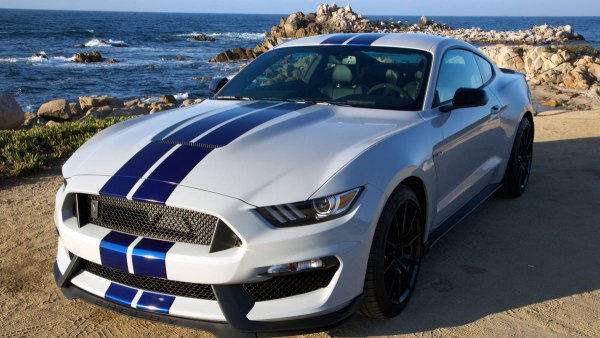
|
Carroll Shelby passed away,
but the GT350 name lives on.
You might remember the original Shelby
GT-350 which debuted 50 years ago. It was the first and until now
the only Mustang that drives like a sports car. Its racing version,
GT-350R, was equally successful on race tracks. That’s a sharp contrast
to its pony car basis. In other words, it was the most “un-stang”
Mustang.
Fast forward to 2015, the legendary model finally gets a worthy
successor. Like the original, the new Mustang GT350 – now losing hyphen
but is still associated with the Shelby moniker – doesn’t seek more
power from a big block V8 or supercharging but a higher revving V8. Its
redline is an amazing 8250 rpm, compared to 7000 rpm on the regular
Mustang V8 GT. Making this possible is a lightweight flat-plane
crankshaft – yes, the same trick as Ferrari V8s (read more info from AutoZine
Technical School). The new engine is derived from the standard 5.0
V8 but is bored out to 5.2 liters. There’s still no direct injection or
variable intake system, but the compression ratio is high enough at
12.0:1. In addition to the high revving nature the V8 manages to break
the barrier of 100 hp per liter. It releases 526 horsepower at 7500
rpm, while maximum torque is 429 lbft at 4750 rpm.
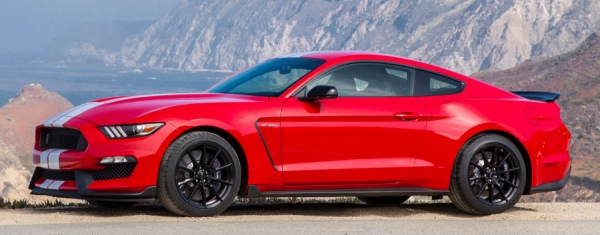
|
This power-biased characteristic is unusual for a Detroit V8. While it
is not short of torque – actually more than a Ferrari 458, the twisting
force increases linearly from 2500 rpm to the peak 4750 rpm and then
keeps almost flat until 7500 rpm, unlike the bottom-concentrated torque
curves of GM or Chrysler’s V8s. This might not suit standing-start
heros, but keen drivers should be delighted as the linear delivery
means the performance is easier to access in the real world. Drive it
on a track and you will be glad that the 8250 rpm redline allows you to
skip upshift in many occasions. The wide power band gives you more
freedom.
Thanks to the lightweight crankshaft, the V8 has very sharp throttle
response. Its rev rises and drops quickly. It also sounds very
different from the usual Detroit V8s. The exhaust note is far rawer,
busier and louder. It’s not the same as Ferrari V8s though, as the
crankshaft arrangement is different (0-180-0-180 degree on one bank,
versus Ferrari’s 0-180-180-0 degree), the intake system is different (a
single plenum instead of two) and exhaust system is also different. The
noise is the most distinctive feature of the GT350.
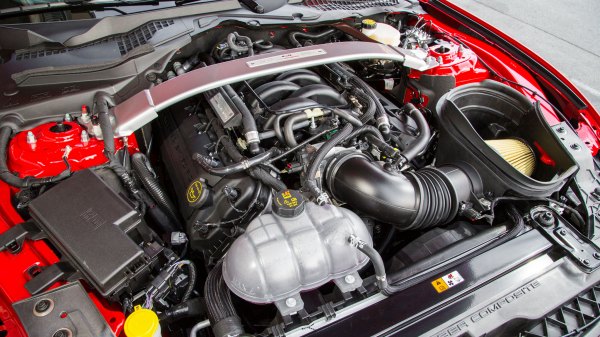
|
The fast-spinning V8 is hooked up to a Tremec 6-speed manual and Torsen
LSD. Gearshift is a little lighter than the Getrag box on standard
Mustang. The clutch is even lighter, probably light to the extent of
unnatural for a performance car. Slicing through the close ratios, you
can guide the GT350 from rest to 60 mph in about 4 seconds, while top
speed is estimated to be 180 mph. Not exactly supercar level, but good
enough to rival a BMW M4 or Cayman GT4.
But the engine is not the only different part, of course. GT350 can be
a GT350 because it is built to excel in corners and on race tracks.
Therefore the chassis and aero are all modified. The reshaped front end
with deeper air dam, underbody trays and rear diffusers enable the car
to claim positive downforce. The new aluminum bonnet has extra openings
to help removing hot air while relieving aero lift. The front fenders
are aluminum as well, and they are flared out to house the wider front
track. Ford said the carbon-fiber grille surround helps reinforcing the
front structure. Under the skin, new front suspension aluminum uprights
are employed to accommodate wider wheels and enable lowered
suspensions. The loss of suspension travel can be compensated with the
addition of magnetorheological adaptive dampers – the first time on a
Ford. Stiffer springs and suspension bushings are used. The brakes are
not ceramic but look at this spec.: Brembo 6-pot and 4-pot monobloc
calipers, 394 mm and 380 mm floating iron discs with aluminum hats. The
tyres are fat Michelin PSS.
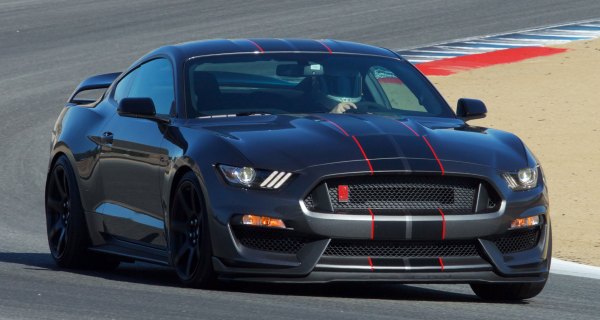
|
On the road, the GT350 is much more agile than the standard Mustang GT,
although it is actually heavier on scale. The brakes are sensational,
the tires offer bags of grip and body control is tidy. The retuned
electrical power steering provides pretty natural feel for its kind.
The nose of the car is mostly obedient. There’s a touch of understeer
when pushed, just as its 54:46 weight distribution suggested, but the
linear engine power allows you to adjust its attitude to neutral and
mild oversteer, all under your control. Its handling is more analogue
than the turbocharged M4 thus is more fun to drive. A Cayman GT4 is
sharper, more agile and more precise in controls, but it is a
thoroughbred sports car. Neither rivals could match the GT350 for sound
though. In terms of drivability, the magnetic dampers give the Mustang
a compliant ride in Normal and Sport mode, whereas Track mode is best
reserved for tracks.
If you regularly join track days, then the track version GT350R should
be opted. This car adds a bigger front splitter, rear spoiler, stiffer
suspension setup, fatter and grippier Michelin PS Cup 2 tires and
lightweight carbon-fiber wheels (it’s the first mass production
application), losing rear seats and 60 kg in the process. Starting at
US$50K and $64K
respectively, the GT350 and GT350R are cheaper than European cars with
comparable power and performance. That’s always the case of Detroit
iron, but this one feels more European than many European cars, in
particular the 8250 rpm V8.
|
Verdict:     |
Published
on 21
Nov 2017
|
All rights reserved.
|
|
Mustang facelift 2017
|
|
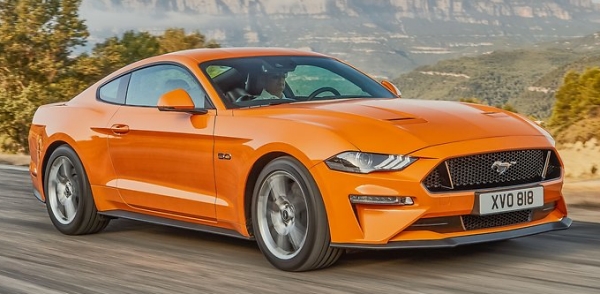
|
|
Revised
Mustang edges further away from its roots of pony cars.
|
|
Ford
sold 150,000 Mustangs last year, 45,000 of which were sold outside its
home country. The globalization has been proved a wise decision as it
successfully defended its market share against SUVs. For comparison,
Chevrolet Camaro and Dodge Challenger sold just 75,000 units and 67,000
units, respectively. The gap between Mustang and its rivals is likely
to widen further following the 2017 facelift.
You can easily distinguish the facelifted Mustang from the outgoing
car. Its nose is made slightly sleeker, more like the GT350, thanks to
a curvier bonnet and a lower mounted front grille. The headlamps are
now full-LED, while the front bumper is heavily revised. At the back,
the main difference lies on the V8 GT, which has switched from dual to
quad-exhaust pipes. Overall, this remains to be a good-looking big
coupe. It has strong presence, no matter move or stationary.
As for mechanical changes, the new car has dropped the long-serving
3.7-liter V6 but improved both the 2.3-liter Ecoboost and 5.0-liter
Coyote V8. The four-cylinder sees no changes in hardware, but its
rewritten ECU adds 30 lbft of overboost for up to 20 seconds, a trick
benefited from the experience of Focus RS. The V8 gets more
comprehensive modifications. Firstly, it replaces cast iron liners with
plasma transferred wire arc spray coating like the GT350. This not only
reduces friction but also enlarges its bore slightly from 92.2 to 93mm,
resulting in a capacity increase to 5038 c.c. Secondly, its port fuel
injection has been upgraded to dual-mode (direct + port) injection.
Accompanied with more knock sensors adopted, this enables its
compression ratio to be raised from 11.0:1 to 12.0:1. Besides, the
engine also gets slightly larger valves, new intake manifold and a
lighter plastic oil pan. As a result, its redline is extended by 500
rpm to 7500 rpm, horsepower is lifted by 25 to 460hp at an
exotic-sounding 7000 rpm, while max. torque is improved by 20 lbft to
420 lbft. The V8 also gets an optional variable exhaust whose Sport
mode opens a valve to enhance exhaust note.
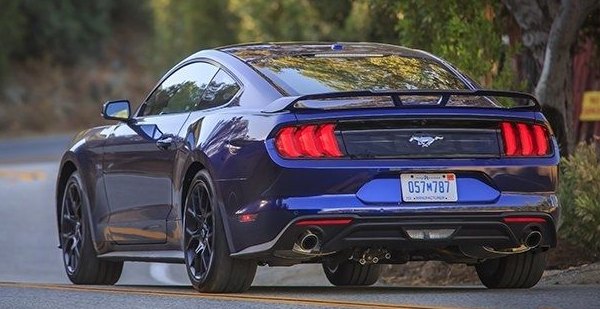
|
|
The
Coyote V8 is quite high-tech now, and it sounds angry.
|
|
On the road, the V8 certainly sounds angrier in any modes other than
“Quiet”, a new mode designed to avoid waking up your neighbours in the
morning. Approaching to its redline, it sounds even closer to a NASCAR
V8! This makes the 2.3 Ecoboost sounds dull and its
mid-range-concentrated power delivery uninspiring. If you buy the
Mustang, it has to be a V8!
The Tremec 6-speed manual gearbox has received closer ratios and new
synchronizers, coupling to a dual-mass flywheel and twin-plate clutch.
The result is smoother and crisper gearshifts and an easily modulated
clutch. Meanwhile, the 6-speed automatic has been replaced with the new
10-speed automatic co-developed with GM (another version already used
in Camaro ZL1). Though not as involving as the manual, it works
brilliantly in its own right, delivering smooth and quick shifts.
Moreover, it adds a Launch mode that will take the car from 0-60 mph
under 4 seconds, claimed Ford.
Predictably, the suspension has been retuned with new dampers,
anti-roll bars and bushings, but the most effective change has to be
the optional magnetorheological adaptive dampers, taken from the GT350.
As the Mustang is a big and nose-heavy coupe, it needs the adaptive
damping to tighten its body motion in corner, and smooth out its ride
in other occasions. It is a must-have option. Steering feel remains a
bit numb, but the revised suspension gives the car sharper turn-in,
edging closer to the territory of GT350.
Not much change is found inside. There are some subtle revisions to
trims, seat materials and padding to address the criticisms about its
interior quality. A new feature is the optional digital instrument,
which is a 12-inch TFT screen whose graphic is switchable, including a
track mode with lap timer. However, adding all the options and
performance package to the V8 could push its price beyond $50,000, not
what you would call pony car pricing. Then again, the Mustang feels
less pony car than ever.
|
Verdict:
   2.3 Ecoboost
2.3 Ecoboost
    5.0 GT
5.0 GT
|
Published
on 16
Aug 2018
|
All rights reserved.
|
|
Mustang Bullitt
|
|
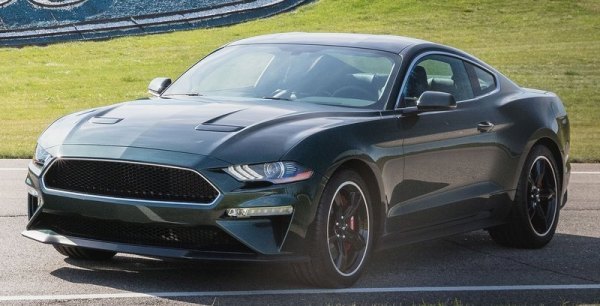
|
|
All
about looks and badge.
|
|
Bullitt
is named after the 1968 Hollywood movie featuring Steve McQueen driving
a Ford Mustang fastback chasing a Dodge Charger R/T. It was regarded as
a classic car chase film. Ford used the name to badge a Mustang special
edition in 2001, and
then
again in 2008. Just as the last two occasions, the latest Mustang
Bullitt is a lightly modified version of Mustang GT, so it sits under
GT350 in the family tree. The modifications are mainly cosmetic,
including black mesh grille, classic black alloy wheels, chromed window
frames and special dark green paint. It looks cool and easily
recognizable on the road, but the regular Mustang GT of this generation
has never been boring.
In terms of mechanical enhancements, there are few. The chassis is just
the
same as the GT’s, although it has the optional performance package
fitted
standard, which includes LSD, stiffer suspension setup, performance
tires and Brembo brakes. The only significant upgrade is the V8, which
gets the freer flowing intake manifolds, larger throttle bodies and
open air box of the GT350. It doesn’t get the latter’s lightweight
flat-plane crankshaft and 8250 rpm redline though, but it feels a tad
stronger than the regular V8 near its 7400 rpm redline, and ultimately
makes another 20 horsepower for a total of 480. We don’t expect its
acceleration to take a giant leap – 0-60 mph probably takes a tenth
less – but at least its speed limiter is lifted from the usual 155 to
163 mph. You might say this top speed is superfluous, because the
Bullitt won’t be sold in Germany or anywhere outside the America. It is
more a
statement than a true benefit, just like all the cosmetic changes and
the Bullitt badge.
|
Verdict:    
|
Published
on 26
Jan 2020
|
All rights reserved.
|
|
Shelby GT500
|
|
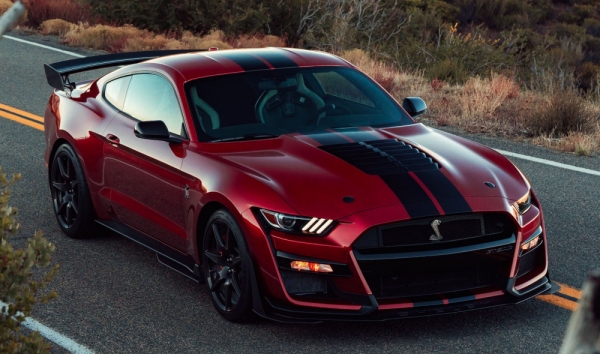
|
|
Super
Mustang offers 760hp and a maturity you might not think of.
|
|
The
days for an absurd, 662-horsepower and live-axle-suspended Mustang
GT500 are over. Like all other members of the 6th generation Mustang,
the new range-topping GT500 is far more matured, sophisticated and
usable than anything ever badged GT500. However, this does not rob it
of absurd numbers. The headline now is 760 horsepower, something
eclipsed by only Dodge Challenger SRT Hellcat Redeye (797hp), and it
outpowers
rival Chevrolet Camaro ZL1 1LE by as much as 110 horsepower. How Ford
achieved
this is quite conventional. Based on the 5.2-liter motor of GT350,
it replaces the low-inertia flat-plane crankshaft with a conventional
cross-plane crankshaft, which is sturdier and therefore capable to
handle far more torque. The arc-wire cylinder coating is retained, as
are the DOHC cylinder heads, but compression ratio is lowered to 9.5:1.
A 2.65-liter Eaton TVS supercharger is
bolted into its V-valley. This is the same supercharger used by the
last
Corvette ZR1, but geared to spin slower and produce a lighter,
0.83 bar boost pressure. Never mind, the Mustang’s DOHC design is more
efficient than GM’s 2-valve pushrodder, capable of spinning to 7500
rpm, so
despite the smaller capacity, it is able to produce 760hp at 7300 rpm.
Yes, peak power at 7300 rpm, doesn’t sound it very European exotic?
Ditto the max. torque of 625 lbft, which is released at a rather high
5000 rpm. This is not the usual American muscle car V8 you might
think of. If you want to compare, I’d recommend a Jaguar 5-liter
supercharged V8. Even in its highest state of tune in the limited
production XE SV Project 8, the Jaguar V8 produced only 600hp and 516
lbft of torque. The GT500 motor is more efficient, more eager to rev
and more European than European.
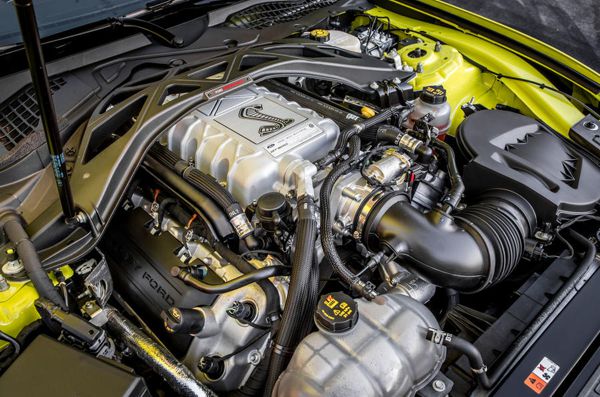
|
|
The
GT500 motor is more European than European...
|
|
The V8 is as loud as a race motor, but like its numbers suggested,
power delivery is linear, surprisingly linear for a muscle car. There
is no particular surge in the mid-range, just revs and rewards you with
proportional output. Some might find it not dramatic enough, but keen
drivers should be happy that its performance is easy to access and
control in real-world driving situations.
Performance is very strong indeed. Its 0-60mph sprint is not
particularly impressive, as Car and Driver recorded a passable 3.6
seconds, which trails Camaro ZL1 1LE by 0.2 sec and Ford's claim by 0.3
sec. This has more to do with the unsophisticated launch control
employed by Ford, and partly due to the car's lighter rear end. Once
the Shelby starts picking up traction, it storms
pass its rival by 100mph. By the time they reach 150, it is already 4
seconds ahead, no contest. Beyond 100mph, it is also quicker than
Nissan GT-R
Nismo, so it is pretty much unbeatable in the world of mass produced FR
2+2 coupes. Curiously, its top speed is limited to only 180mph, whereas
the last GT500 topped 200mph.
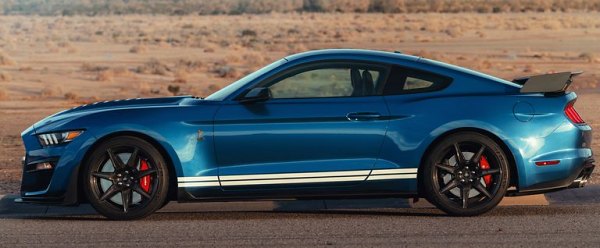 |
|
Performance
is pretty much unbeatable in the world of mass produced FR 2+2 coupes.
|
|
Apart from engine, the GT500 betters GT350 by using a Tremec 7-speed
twin-clutch gearbox. It is the American gearbox specialist's first DCT,
but it is well developed. Gearshift is quick and smooth, trailing not
much behind the leading Porsche PDK. However, keen drivers might moan
the absence of manual gearbox, which is more fun if slower. They could
be better served by the GT350.
The GT500 can be easily spotted from lesser Mustangs by its massive
grille, which increases engine cooling by 50 percent, and a pronounced
hood with vents. It also spots wider fenders to accommodate the wider
Michelin PS 4S tires. Power goes to the rear wheels through a Torsen
limited slip differential. There is no active diff, disappointingly but
understandably on the ground of cost. Predictably, brakes are enlarged
to cope with the extra performance. Brembo 6-pot calipers clamp 420mm
dual-material discs up front, 4-pot calipers and 370mm discs at
the rear. Suspension gets stiffer springs and anti-roll bars, while the
magnetorheological adaptive dampers have been retuned. A magnesium
brace reinforces the front suspension towers.
At $74,000, the base GT500 is not overpriced, but when you add the
optional Track package, you will push its price to an alarming $93,000.
This package adds lightweight carbon-fiber wheels and aero kits,
including an adjustable rear wing which achieves net downforce at
speed. Besides, it has the rubbers upgraded to sticky Michelin PSS Cup
2,
while the rear seat is ditched to trim weight.
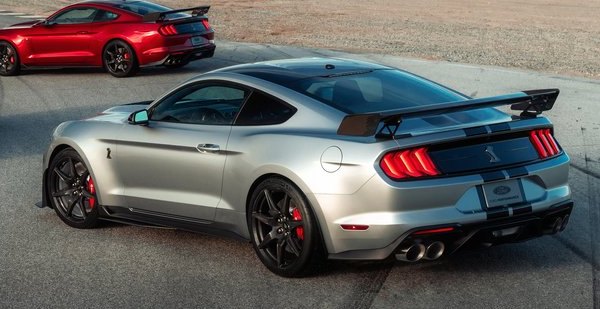 |
|
Heavier
and more unbalanced, the GT500 is not quite as good to drive as GT350R.
|
|
Even in this exotic form, the GT500 is not quite as good to drive as
the lighter, purer and higher-revving GT350R. When you really push it,
you will feel its 180kg of
extra
weight and poorer balance. This is a 1840kg machine, and
57 percent of which is acted on the front axle, so it could struggle
for traction. It is never difficult to
drive, but it is less agile and less precise than its smaller brother.
Response is slower, steering is more numb, and you need to back off
earlier before reaching corners. For comparison, rival Camaro ZL1 1LE
has better balance and tighter body control, allowing you to use more
of its power. As a track car, the Camaro is certainly a better
companion. As a road car, however, the super Mustang is more usable,
because it leaves enough suspension compliance to deal with normal
roads. Considering the performance it offers, it rides remarkably
supple.
This means the GT500 is not necessarily better than the cheaper GT350,
just has a
different set of priorities: accessible power and superior straight
line performance while retaining day-to-day usability. It is certainly
more versatile than Camaro ZL1 1LE and Challenger Redeye. Like a BMW
M4 CS, just with 300 more horsepower, a more exciting looks and a
superior aural
experience. It is a nice effort to bridge the gulf between American
muscle cars and European performance coupes, but I am not sure if it is
good enough to convince the fans of both worlds.
|
Verdict:    
|
Published
on 8
Sep 2021
|
All rights reserved.
|
|
Mustang Mach 1
|
|
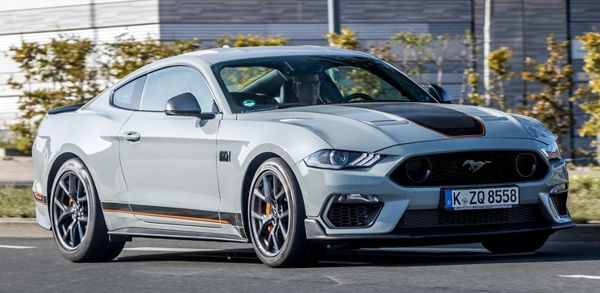
|
|
Another
Mustang taking on track days attendees.
|
|
Bridging
the standard GT and Shelby GT500, this is the closest thing to the
discontinued, highly regarded GT350 (and GT350R). Like that car, it is
supposed to be a Mustang designed for track days attendees. To that
end, it gets the GT350’s close-ratio 6-speed Tremec gearbox (with
rev-matching), engine and transmission oil coolers as well as a
stronger
rear subframe. The latest GT500 donates its aero kits (e.g. rear wing
and diffusers) and rear toe-control links. There are also stiffer
suspensions and standard magnetic adaptive dampers.
However, the Mach 1 – a nameplate last used by Mustang in 2003 – is a bit weak on
power. Its 5.0 V8 lacks the GT350’s high-revving flat-plane crankshaft.
Transplanted straight from the outgoing Bullitt, it is basically a
standard V8 added with the high-flow intake manifolds of GT350. No
wonder its output is 20 horses more than the regular GT but 46 ponies
shy of the GT350. Carrying slightly more weight than the GT350 doesn’t
help either. The Mach 1 takes 4.3 seconds to sprint from rest to 60
mph, virtually inseparable from the regular GT. By today’s standards,
anything taking more than 3-point-something seconds should not be
confused with the speed of sound.
The Mach 1 starts at a tempting $53,000, but the “trackability” of that
car is limited by its road-going Michelin Pilot 4S tires. To get
track-ready Cup 2 tires, you need to tick the optional Handling
package, which comes with unique alloy wheels and extra spoilers as
well. As such equipped, the Mach 1 is a faithful track machine,
offering high g-force, strong braking and a stable cornering manner. It
is not a Lotus or a Porsche on track, as it could feel heavy at the
nose, preferring measured application of steering and throttle to keep
it fluent in corners. Abusing the chassis will turn understeer into
oversteer, and it won’t be as easy to tame as lighter cars. The
steering is accurate enough, but short of feel and gives little
indication of how much front-end grip left. On public roads, the
steering kickbacks nervously over rough surfaces, very good school.
Like the outgoing Bullitt, the Mach 1 is a limited time offering that
utilizes the vast parts pool of Mustang to catch the enthusiastic end
of its customer base. It does not move the game forward, nor introduces
any new inspiration, unlike the GT350 or GT500.
|
Verdict:   
|
|